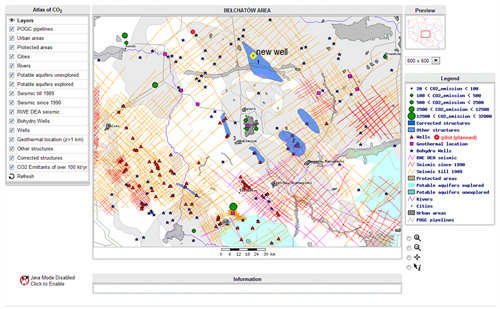Storage(CO2) A process for retaining captured CO2, so that it does not reach the atmosphere in onshore aquifers offers a large potential and might be the only choice for inland areas (one example from central Poland, about 400 km from Baltic coast is shown in Fig. 2-9). This is, however, a sensitive issue because of high population density in and around areas where large industrial CO2Carbon dioxide emission sources are present (Vangkilde-Pedersen, 2008) and public opposition may not be uncommon.
Safety issues need to be addressed during the site selection phase, otherwise the whole selection process may need to be revised. In general, the provisions of the 2009/31/ECEuropean Commission Directive on geological storage(CO2) A process for retaining captured CO2, so that it does not reach the atmosphere of carbon dioxide, in particular Annex 1 to the Directive, can be applied as the first step based on available data.
| 
Fig. 2-9: Storage(CO2Carbon dioxide) A process for retaining captured CO2Carbon dioxide, so that it does not reach the atmosphereThe layer of gases surrounding the earth; the gases are mainly nitrogen (78%) and oxygen (around 21%) options for the Bełchatów CCSCarbon dioxide CaptureThe separation of carbon dioxide from other gases before it is emitted to the atmosphereThe layer of gases surrounding the earth; the gases are mainly nitrogen (78%) and oxygen (around 21%) and Storage demo project in central Poland (Polish National Programme on Safe CO2Carbon dioxide Storage(CO2Carbon dioxide) A process for retaining captured CO2Carbon dioxide, so that it does not reach the atmosphereThe layer of gases surrounding the earth; the gases are mainly nitrogen (78%) and oxygen (around 21%): http://skladowanie.pgi.gov.pl). |
A preliminary model of the storage(CO2Carbon dioxide) A process for retaining captured CO2Carbon dioxide, so that it does not reach the atmosphereThe layer of gases surrounding the earth; the gases are mainly nitrogen (78%) and oxygen (around 21%) site is then constructed; possible hazards are identified; exposures and effects on humans and the environment (e.g. groundwater resources) are assessed; the Risks are evaluated together with sensitivity assessment (importance of particular parameters of the model - Tab. 2-7); and finally possible risks to health, safety and environment are summarised.
| Tab. 2-7: Parameters important for evaluation of storage(CO2Carbon dioxide) A process for retaining captured CO2Carbon dioxide, so that it does not reach the atmosphereThe layer of gases surrounding the earth; the gases are mainly nitrogen (78%) and oxygen (around 21%) safety in onshore saline aquifers (after Chadwick et al., 20062006 - R. A. Chadwick, O. Eiken, P. Williamson, G. WilliamsGeophysical monitoring of the CO2 plume at Sleipner, North Sea: an outline reviewsee more). | Parameter | Depth (of the reservoirA subsurface body of rock with sufficient porosityMeasure for the amount of pore spaceSpace between rock or sediment grains that can contain fluids in a rock and permeabilityAbility to flow or transmit fluids through a porous solid such as rock to store and transmit fluids) | CaprockRock of very low permeability that acts as an upper seal to prevent fluid flow out of a reservoir thickness | CaprockRock of very low permeability that acts as an upper seal to prevent fluid flow out of a reservoir quality and integrity | Capillary entry pressureAdditional pressure needed for a liquid or gas to enter a pore and overcome surface tension | Closure | Salinity | | Description | CO2Carbon dioxide in supercritical(CO2Carbon dioxide) Conditions where carbon dioxide has some characteristics of a gas and some of a liquid phase (depth and pressure correlate wellManmade hole drilled into the earth to produce liquids or gases, or to allow the injectionThe process of using pressure to force fluids down wells of fluids, temperature depends on local geothermalConcerning heat flowing from deep in the earth gradient) | Primary at least of 20 m, recommended over 100 m and/or other caprockRock of very low permeability that acts as an upper seal to prevent fluid flow out of a reservoir complexes above | Low permeabilityAbility to flow or transmit fluids through a porous solid such as rock, high capillary entry pressureAdditional pressure needed for a liquid or gas to enter a pore and overcome surface tension, rather no faulting and lateral facies' changes within the caprockRock of very low permeability that acts as an upper seal to prevent fluid flow out of a reservoir complex | Much higher than buoyancyTendency of a fluid or solid to rise through a fluid of higher density force of the column of CO2Carbon dioxide injected (injectionThe process of using pressure to force fluids down wells simulations assess the safe amount of CO2Carbon dioxide) | AnticlineFolded geological strata that is convex upwards height sufficient the plume will not exceed the spill pointThe structurally lowest point in a structural trap that can retain fluids lighter than background fluids (injectionThe process of using pressure to force fluids down wells simulations necessary in order to assess safe amount) | Over 30 g/l guarantees no exchange of brine with potable water occurs in the reservoirA subsurface body of rock with sufficient porosityMeasure for the amount of pore spaceSpace between rock or sediment grains that can contain fluids in a rock and permeabilityAbility to flow or transmit fluids through a porous solid such as rock to store and transmit fluids; if less porewater analyses necessary | |